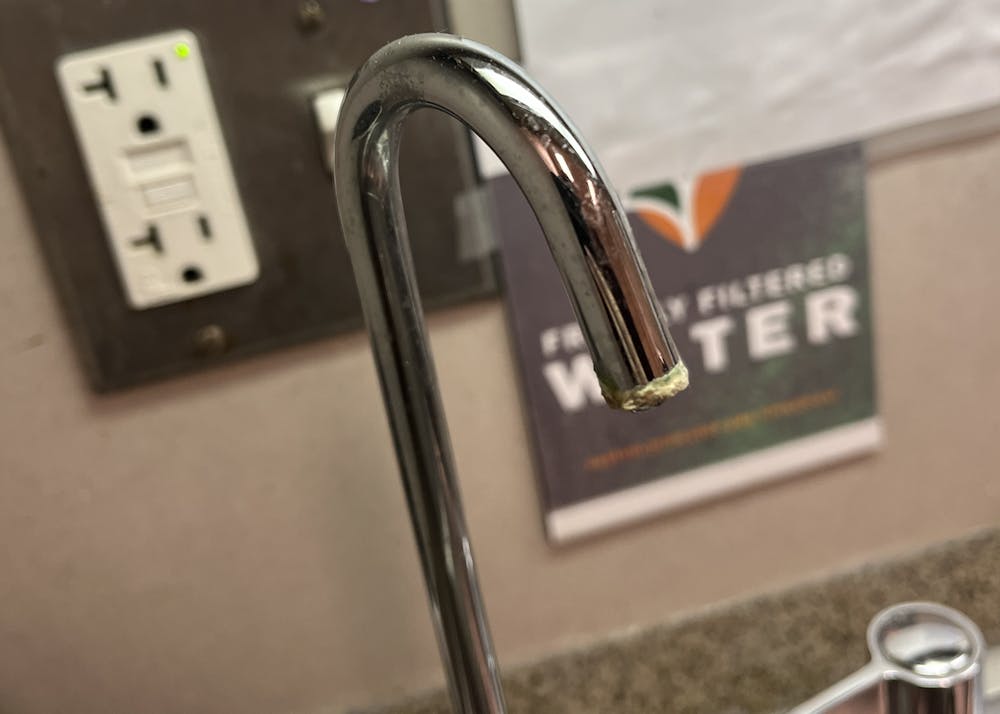The University’s Office of Sustainability boasts “more than 250 filtered water bottle-filling stations.” Yet the fountains on campus vary significantly, having been installed at different times.
On Oct. 28, The Daily Princetonian collected and tested water from 38 drinking fountains from around campus using a Walfront multifunction digital water tester. Staffers collected from 22 residential and 16 non-residential buildings, and from 20 filtered and 18 unfiltered fountains — as well as the fountain of the School of Public and International Affairs (SPIA), which is not a drinking fountain.
According to the Princeton Environmental Health and Safety (EHS) website, “Campus drinking water is supplied by NJ American Water. EHS and Facilities work together to prevent and respond to concerns regarding drinking water.” The page recommends that students reach out to facilities if they have concerns about their water.
The ‘Prince’ tested samples for pH, electrical conductivity, total dissolved solids, and salinity. The drinking fountains were consistently within the World Health Organization (WHO) and Environmental Protection Agency (EPA) guidelines for Total Dissolved Solids (below 300 ppm for the best water quality) and Electrical Conductivity (less than 1000 microsiemens per centimeter). Salinity was also consistently 0.02 percent salt, except for in the Witherspoon basement, which was 0.03 percent.
For pH, seven of the tested fountains fell below the WHO-recommended range of 6.5-8.5, though all were above 6.3. Five of the seven were filtered water fountains or faucets: in Edwards Hall basement, Holder Hall basement (near entryway 1), Henry Hall kitchen, Joline Hall entryway 3, and in EQuad D wing basement. The other two, one on the second floor of Little Hall and the other in Campbell Hall basement of entryway 2, were not filtered.
Zhiyong Jason Ren, a Professor of Civil and Environmental Engineering and the Andlinger Center for Energy and the Environment, stressed that other factors like lead and bacteria are important to measure, but pH is also important in water quality. “If [pH] is six point something, we will need to look into that, but there’s a lot of sports drinks and other things that have acidic pH. It’s not like water has to have a pH of seven.”

The ‘Prince’ noticed calcium buildup on many of the water spigots, including those for filtered water. Ren noted that he didn’t think that the buildups were necessarily a huge issue.
“It [can] block the filter and may add hardness, but it’s not a common water [quality] criteria,” Ren told the ‘Prince.’ “You probably need to soften it … but honestly I don't feel that’s an issue. That’s my gut feeling — I don’t have scientific data.”
Some students expressed their dissatisfaction with both water fountain quality and location in their dorms. As Madhalasa Iyer ’27, resident of Campbell Hall, explained, “one of the biggest challenges that we face in Campbell Hall is that our water fountain is down two flights of stairs.” Campbell Hall (in Rockefeller College) houses one water fountain in its basement. Iyer said that she avoids the Campbell Hall water, opting instead for the fountains in Frist Campus Center. “When I do drink [the Campbell water] it tastes a lot like swimming pool chlorinated water,” she noted.
Nina Boudet ’25 expressed a similar sentiment in a statement to the ‘Prince,’ writing, “I always found that there were few places to get filtered water but I thought that water would at least be clean.”

The ‘Prince,’ on the other hand, does not recommend drinking from outdoor decorative fountains. Of the two outdoor fountains the ‘Prince’ tested, the large, square fountain outside the Lewis Center for the Arts performed similarly to potable water locations on campus along the same metrics. Despite having a level of dissolved solids theoretically acceptable for drinking, dirt and insects were visibly present in the water. The water tester that the ‘Prince’ used does not detect the presence of bacteria or other microorganisms.
The SPIA fountain, on the other hand, would be considered dangerous to drink by WHO and EPA standards. While the pH fell within the recommended range (7.13), the electrical conductivity and total dissolved solids were too high to measure. The campus average in electrical conductivity was 493 microsiemens per centimeter, far less than the recommended less than 1000 microsiemens per centimeter. The SPIA fountain, on the other hand, measured at 1461 microsiemens per centimeter. Similarly, the campus average for total dissolved solids (245 ppm) was within the recommended range of below 300 ppm. The SPIA fountain measured at 717 ppm, which is higher than what the WHO deems as “good” drinking water.
Alexa Wingate is a contributing Data writer for the ‘Prince.’
Charlie Roth is a head Data editor for the ‘Prince.’
Assistant Data Editors Suthi Navaratnam-Tomayko and Andrew Bosworth, and Senior Data Writer Madeleine LeBeau contributed reporting.








